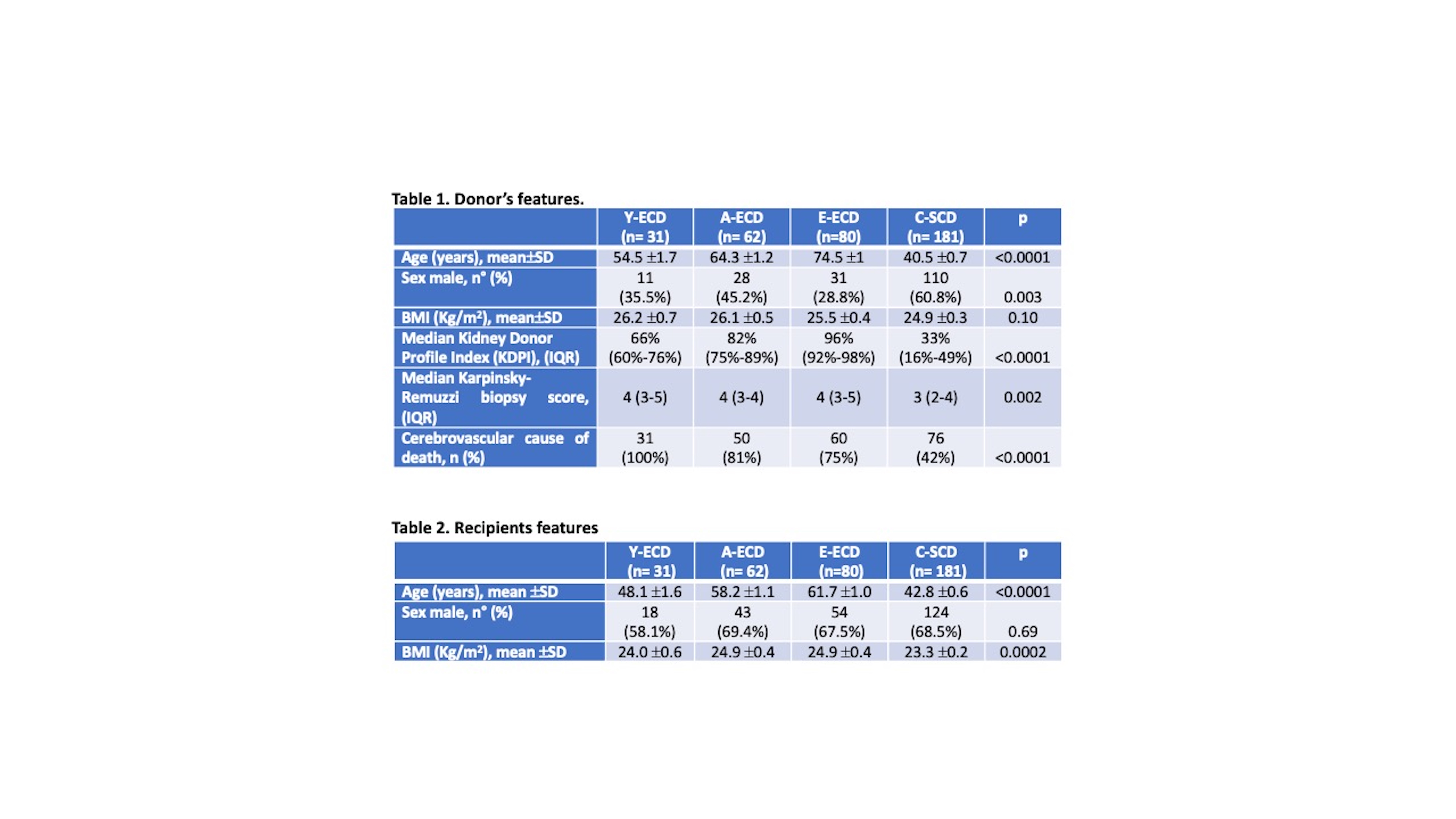Do all the expanded criteria donors offer the same outcome? A comparison from a single center
Emanuele Federico Kauffmann1, Concetta Cacace1, Niccolo' Napoli1, Vittorio Perrone1, Gabriella Amorese2, Francesca Costa1, Giacomo Taddei1, Michael Ginesini1, Ugo Boggi1, Fabio Vistoli1.
1Division of General and Transplant Surgery, Azienda Ospedaliera Universitaria Pisana, Università di Pisa, Pisa, Italy; 2Division of Anesthesia and Intensive Care, Azienda Ospedaliera Universitaria Pisana, Università di Pisa, Pisa, Italy
Introduction: The quality of deceased donors is gradually worsening and the clinical category of expanded criteria donor (ECD) includes an always increasing donor population, but not all the single kidney transplants (SKTx) from ECD seem to have similar results. We analyze the outcome of SKTx from ECD stratified by age and compared to SKTx from standard criteria donors (SCD).
Method: We considered patients underwent SKTx to our Center from January 2005 to December 2021. We considered 4 groups: Young (Y)-ECD, SKTx from ECD 50–59-year-old with at least 2 features between: creatinine >1.5mg/dl, arterial hypertension or cerebrovascular accident, in any combination; Aged (A)-ECD: SKTx from ECD 60–69-year-old; Elderly (E) ECD: SKTx from ECD ≥70 year-old, and the Control (C)-SCD: SKTx from SCD <60 year-old. Groups were compared for primary non function (PNF), delayed graft function (DGF), vascular thrombosis, urinary leakage, acute rejection rate, cumulative complication index (CCI), e-GFR (CKG EPI), 1-, 5-, 10-year patient survival.
Results: Overall 354 patients underwent SKTx: mean donors age was 53.6 ±17.1 years, mean BMI was 25.4 ±3.9. C-SCD-n=181 and 173 (48.9%) were from ECD, stratified as follows: Y-ECD-n=31, A-ECD-n=62, E-ECD-n=80. The main characteristics of the donors and recipients in the study population are reported in the Table 1 and 2. he groups presented differences in donors age (p<0.0001), median KDPI (<0.0001), median Remuzzi-Karpinsky biopsy score (p= 0.002) and rate of cerebrovascular events as cause of donors death (p<0.0001). The main results of the analysis are reported in the Table 3. Regarding the outcomes, there were no differences in terms of PNF, DGF, CCI, acute rejection and vascular thrombosis rates. The urinary leakage occurred more frequently in E-ECD (p=0.04). The 3-month e-GFR have been superior in C-SCD than the other three groups (p=0.01 vs Y-ECD; p<0.0001 vs A-ECD; p<0.0001 vs. E-ECD). Same advantage in favor of C-SCD was recorded for 1-year and 5-years eGFR (p<0.0001 and p=0.019).
Conclusion: The SKTx from E-ECD present a significantly lower e-GFR compared the others ECD and to C-SCD. Nevertheless, all SKTx from any ECD have post-operative outcome similar to C-SCD and comparable patient and graft survival, in short and long-term. E-ECD, when used for SKTx, should be used in carefully selected recipients with limited needs in terms of depuration (older, small in size, little musculature). Moreover, a larger use of calcineurin inhibitor free immunosuppressive regimens could improve results in long term.


right-click to download
